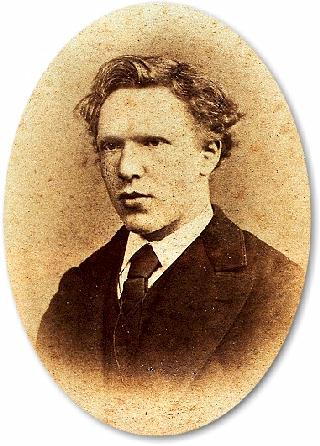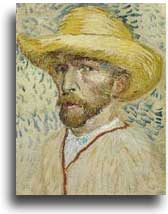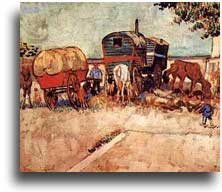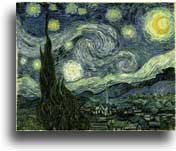|
Van
Gogh was an indisputable genius, utterly, indisputably ignored. He
created hundreds of bold, brilliant paintings; only one was sold
during his lifetime. He suffered from Paranoid Schizophrenia
and ultimately committed suicide in 1890.
Here follows a brief outline of the life and times of this genius. Early
Life and Family:
Vincent
Van Gogh,the eldest of six children was born to Theodorus
van Gogh and Anna Cornelia Carbentus on on March 30, 1853, in
Zundert, a village in Brabant, in the south of the Netherlands. He
excelled in languages, studying French, English, and  German. In
March 1868, in the middle of the academic year, he abruptly left
school and returned to Zundert. He did not resume his formal
education. Van Gogh, being the son of a Lutheran minister, was very
much drawn toward religion. Van Gogh decided to prepare himself
for ministry by training in the study of theology. He failed at
the courses and could not be the minister he hoped to become. Even
though he failed the courses, he still had the desire to be a
minister. His superiors sent him as a lay missionary to Belgium
instead. There he wanted to be like his father and help out the
unfortunates as a preacher. He tried to fight poverty through the
teachings of Christ. Van Gogh’s mission had to be discontinued.
His approach to fighting poverty did not make his superiors happy.
In 1879, he moved to his father’s home in Ettan and stayed a
while. He then left Ettan and went to The Hague. German. In
March 1868, in the middle of the academic year, he abruptly left
school and returned to Zundert. He did not resume his formal
education. Van Gogh, being the son of a Lutheran minister, was very
much drawn toward religion. Van Gogh decided to prepare himself
for ministry by training in the study of theology. He failed at
the courses and could not be the minister he hoped to become. Even
though he failed the courses, he still had the desire to be a
minister. His superiors sent him as a lay missionary to Belgium
instead. There he wanted to be like his father and help out the
unfortunates as a preacher. He tried to fight poverty through the
teachings of Christ. Van Gogh’s mission had to be discontinued.
His approach to fighting poverty did not make his superiors happy.
In 1879, he moved to his father’s home in Ettan and stayed a
while. He then left Ettan and went to The Hague. Impressonism
and the City:
After
leaving Belgium, he found he enjoyed painting stuff that moved him
emotionally. He then thought painting would be the way to go in
his life. On February 27, 1886, Vincent arrived in Paris. He lived
with Theo in Montmartre, an artists' quarter. The move was formative in the development of his painting style. Theo, who
managed the Montmartre branch of Goupil's (now called Boussod,
Valadon & Cie), acquainted Vincent with the works of Claude
Monet and other Impressionists. Previously he had known only Dutch
painting and the French Realists; now he saw for himself how the
Impressionists handled light and color, and treated their original
themes from the town and country. For four months Van Gogh studied
at the prestigious teaching atelier of Fernand Cormon, and he
begans to meet the city's modern artists, including Paul Gauguin,
Henri de Toulouse-Lautrec, Emile Bernard, Camille Pissarro, and
John Russell.  New
Approaches to his works: Vincent's
Paris work was an effort to assimilate the influences around him.
As he began to formulate his own artistic idiom, he progressed through the styles and subjects of the Impressionists. His palette
become brighter, his brushwork more broken. Like the
Impressionists, Vincent took his subjects from the city's cafés
and boulevards, and the open countryside along the Seine River.
Through Georges Seurat and Paul Signac, he discovered the stippling
technique of Neoimpressionism, also called Pointillism, and freely
experimented with the style. "What is required in art
nowadays," he wrote, "is something very much alive,
very strong in color, very much intensified." His interest in
portraiture became imminent when he painted 20 portraits in Paris.
Soon after arriving in Paris, Vincent sensed how outmoded his
dark-hued palette has become. He painted studies of flowers, which
Theo describes as "finger exercises"-practice pieces in
which he tried to "render intense color and not a gray
harmony." His
palette gradually lightened, and his sensitivity to color in the
landscape intensifies. Vincent regularly painted outdoors in Asnières,
a village near Paris where the Impressionists often set up their
easels. Vincent found it difficult to work in Paris and moved to
Provence, Southern France. He painted the landscape. It conveyed
particular emotions, an innovation that aligned his work with Postimpressionism.
In
December, Vincent faced a psychotic episode and had a row with
Gauguin a fellow painter, who lived with him and later cut off a
piece of his own left ear. He was admitted to a hospital in Arles
and remained there through January of 1889. New
Approaches to his works: Vincent's
Paris work was an effort to assimilate the influences around him.
As he began to formulate his own artistic idiom, he progressed through the styles and subjects of the Impressionists. His palette
become brighter, his brushwork more broken. Like the
Impressionists, Vincent took his subjects from the city's cafés
and boulevards, and the open countryside along the Seine River.
Through Georges Seurat and Paul Signac, he discovered the stippling
technique of Neoimpressionism, also called Pointillism, and freely
experimented with the style. "What is required in art
nowadays," he wrote, "is something very much alive,
very strong in color, very much intensified." His interest in
portraiture became imminent when he painted 20 portraits in Paris.
Soon after arriving in Paris, Vincent sensed how outmoded his
dark-hued palette has become. He painted studies of flowers, which
Theo describes as "finger exercises"-practice pieces in
which he tried to "render intense color and not a gray
harmony." His
palette gradually lightened, and his sensitivity to color in the
landscape intensifies. Vincent regularly painted outdoors in Asnières,
a village near Paris where the Impressionists often set up their
easels. Vincent found it difficult to work in Paris and moved to
Provence, Southern France. He painted the landscape. It conveyed
particular emotions, an innovation that aligned his work with Postimpressionism.
In
December, Vincent faced a psychotic episode and had a row with
Gauguin a fellow painter, who lived with him and later cut off a
piece of his own left ear. He was admitted to a hospital in Arles
and remained there through January of 1889.
 Work
In the Asylum: Vincent
suffered from severe psychological breakdown.1889. He
voluntarily admited himself to the psychiatric hospital in
Saint-Rémy, 15 miles from Arles. The admitting physician,
Dr. Théophile Peyron, noted that Vincent suffered from
"acute mania with hallucinations of sight and
hearing." But he continued painting. Vincent was sometimes without the stamina or confidence to execute
original works. He regained his bearings by painting copies
after his favorite artists, including Millet, Rembrandt,
and Delacroix. Relying on his collection of prints,
Vincent translated the black and white reproductions into
his own intensely personal color compositions. He made
more than twenty copies of Millet's peasant scenes, and he
reinvented Delacroix's Pieta, in which the bearded Christ
beared some resemblance to himself. After one particularly
violent attack, in which he attempted to poison himself by
swallowing paint, Vincent was forced for a time to confine
himself to drawing. Work
In the Asylum: Vincent
suffered from severe psychological breakdown.1889. He
voluntarily admited himself to the psychiatric hospital in
Saint-Rémy, 15 miles from Arles. The admitting physician,
Dr. Théophile Peyron, noted that Vincent suffered from
"acute mania with hallucinations of sight and
hearing." But he continued painting. Vincent was sometimes without the stamina or confidence to execute
original works. He regained his bearings by painting copies
after his favorite artists, including Millet, Rembrandt,
and Delacroix. Relying on his collection of prints,
Vincent translated the black and white reproductions into
his own intensely personal color compositions. He made
more than twenty copies of Millet's peasant scenes, and he
reinvented Delacroix's Pieta, in which the bearded Christ
beared some resemblance to himself. After one particularly
violent attack, in which he attempted to poison himself by
swallowing paint, Vincent was forced for a time to confine
himself to drawing.
|
|
 His
masterpieces: While
in Arles, and Saint-Rémy as well, Vincent sent his
canvases to Theo in Paris. Despite his illness, he painted
one masterwork after another during this time, including
Irises, Cypresses, and The Starry Night. His works started
getting recognition. The progressive Belgian artists'
group Les Vingt included six of his paintings in their
1890 exhibition. Vincent left for Auvers-sur-Oise, near
Paris. Vincent set about painting portraits of his new
acquaintances and the local landscape, including nearby
wheatfields and the garden of the painter Daubigny. He
worked with great intensity, he produces nearly a
painting a day over the next two months. A series of 12
canvases in a distinctive panoramic format celebrates
country life. His
masterpieces: While
in Arles, and Saint-Rémy as well, Vincent sent his
canvases to Theo in Paris. Despite his illness, he painted
one masterwork after another during this time, including
Irises, Cypresses, and The Starry Night. His works started
getting recognition. The progressive Belgian artists'
group Les Vingt included six of his paintings in their
1890 exhibition. Vincent left for Auvers-sur-Oise, near
Paris. Vincent set about painting portraits of his new
acquaintances and the local landscape, including nearby
wheatfields and the garden of the painter Daubigny. He
worked with great intensity, he produces nearly a
painting a day over the next two months. A series of 12
canvases in a distinctive panoramic format celebrates
country life.
|
|
 Despair:
In
early July Vincent visited Theo in Paris. Frustrated by his work at
Boussod's, Theo considered setting up his own business, and he
warned Vincent that they will all have to tighten their belts.
Strongly affected by Theo's dissatisfaction, Vincent grew increasingly tense: "My life is also threatened at the very
root, and my steps are also wavering." On July 27, 1890,
Vincent walked to a wheat field and shot himself in the chest. He
stumbled back to his lodging, where he dies two days later, on
July 29, with Theo at his side. Despair:
In
early July Vincent visited Theo in Paris. Frustrated by his work at
Boussod's, Theo considered setting up his own business, and he
warned Vincent that they will all have to tighten their belts.
Strongly affected by Theo's dissatisfaction, Vincent grew increasingly tense: "My life is also threatened at the very
root, and my steps are also wavering." On July 27, 1890,
Vincent walked to a wheat field and shot himself in the chest. He
stumbled back to his lodging, where he dies two days later, on
July 29, with Theo at his side.
|
Aftermath:
The
paintings were inherited by Theo his brother. After Theo's death
in 1891, his wife, Joanne and son
Vincent Willem van Gogh (1890-1978) inherited this legacy. Later
Vincent Willem Van Gogh transfered the works he owned to the newly
formed Vincent van Gogh Foundation in 1962. Construction of the
museum building, designed by the modernist Dutch architect Gerrit
Rietveld, begans in 1969. The museum officially opened its doors in
1973. Since then, the building houses the largest collection of
works by Vincent van Gogh, on loan from the Vincent van Gogh
Foundation. Great
things are done by a series of small things brought together.
------------Vincent
Van Gogh Love
is something eternal, the aspect may change, but not the essence.
--------------Vincent
Van Gogh Back
to Icons Home page
|
